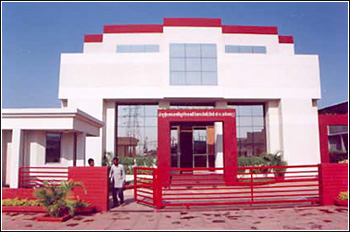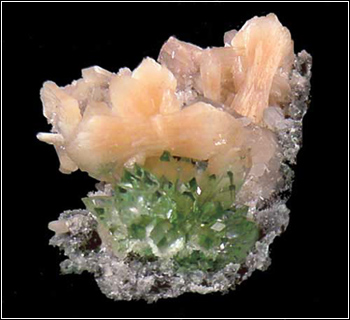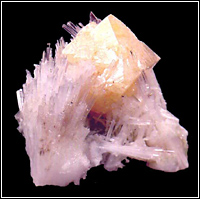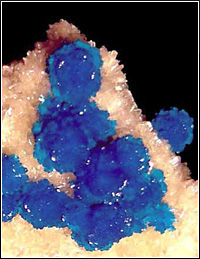
Copyright
The Gargoti Mineral Museum,
Nasik, India
By John Biczok
On April 26, 2001, I had the pleasure of attending the grand opening of what has to be one of the finest private mineral museums in the world. It might surprise most mineral enthusiasts to hear that this incredible building and the stunning collection it houses are located in Nasik, India. While India is a prolific producer of wonderful zeolite minerals that are sought after by collectors worldwide, there are only a handful of true mineral collectors in this nation of 1 billion people and mineral displays in government museums are shabby at best. The Gargoti Museum is the superbly completed vision of one Indian, mineral dealer and retired naval officer, Mr. K.C. Pandey.
| |

Figure 1: This world class blue-green Aquamarine from Tamilnadu (Southern India) is 31 cm high and measures 47 cm in circumference. It weighs 9.7 kilograms. Photo by K.C. Pandey, Superb Minerals India.
|
K.C. Pandey became fascinated with minerals at the age of 16 when he first visited Mumbai for a job interview with the Indian navy. Zeolites are sold in most flea markets and from roadside stands in Mumbai and KC soon became obsessed with mineral collecting after seeing these beautiful specimens. During his naval career he kept up his collecting and after taking early retirement in 1994 he decided to pursue a second career as a mineral dealer. Within a few short years he became the leading dealer of Indian minerals and presently exports about 80% of the specimens sold on the world market. Although the zeolites from the Deccan traps (old lava flows) form the majority of his material, he has also acquired and dealt in million dollar aquamarine crystals from southern India (Figure 1), Mysore rubies, and spectacular smokey quartz clusters from the Himalaya Mountains.
KC soon began to dream of building a museum in India that would do justice to the beauty of the countries mineral specimens. His dream was supported by one collector in particular, the brilliant American mathematician Steve Smale. He met Mr. Pandey several years ago and not only became one of his best customers but an ardent supporter of his museum dream. After years of toil and an expense of about $5 million (Canadian dollars), the Gargoti Museum in the heart of the Deccan traps was ready for its official unveiling on April 26, 2001 (the word Gargoti means "stones" in the official language of the State of Maharashtra - Marathi). The guest list for this occasion contained some 2,000 names including Steve Smale, dealers from Germany and France, a group of English collectors, and hundreds of local and State politicians. After the opening ceremonies in a huge outdoor tent, this beautiful building designed by Mr. Pandey himself was opened to the public (Figure 2).

Figure 2: The Gargoti Museum in Nasik, India.

Figure 3: This top quality specimen from Nasik contains a cluster of light green cubical apophyllite crystals, crystals of pink stilbite and yellow calcite, and a unique crystal form of scolecite from Nasik. It measures 17 x 17 inches. Photos by K.C. Pandey, Superb Minerals India.
|
| |
 (A)
(A)

(B)
Figure 4: (A) This fantastic specimen from Nasik is a beautiful spray of scolecite on a stilbite base. The specimen measures 10 inches high. (B) This truly unique specimen from Ahmed Nagar contains a rare crystal of powellite nested within a spray of scolecite. The powellite measures 2 x 2.5 inches. The specimen is 4.5 inches high. Photos by K.C. Pandey, Superb Minerals India.

Figure 5: A top quality specimen of cavansite. Photo by K.C. Pandey, Superb Minerals India.
|
Upon entering the museum one walks along a short hallway lined with 2-3 ft wide "decorator" type of specimens, principally large plates of apophyllite (Figure 3) and other zeolites, but also a wonderful Indian amethyst. The hallway soon opens into a spectacular 3 story high, circular, domed lobby. A 13-ft high statue of Mother India and a lion astride a large sphere occupies the centre of the lobby. The ceiling is a glass dome painted with a colourful map of the world. At night the light from the lobby makes this globe shine for miles around. A circular walkway leads from the lobby to the first of the galleries, "The Deccan Plateau". Words can barely describe the wondrous collection and the beautiful, well-lit display cabinets in this room. The cases are about 8 ft tall with teak backs and sides and glass fronts from top to bottom. Two full cases are reserved for stunning collections of white scolecite sprays (Figure 4) up to 60 cm long and gorgeous blue cavansite specimens (Figure 5). Other cases feature the many lustrous colours of heulandite in combination with pink stilbite, quartz and green apophyllite. The heulandites range from a light salmon pink to reddish brown and grass green. Fluffy okenite and gyrolite filled geodes, slender, gravity defying stalactites up to 30 cm long coated with sparkling combinations of stilbite, apophyllite, and quartz, spectacular perfect hemispheres up to 30 cm across of radiating white natrolite on matrix ... the list of eye-popping specimens if too numerous to record here. Just imagine the best zeolite minerals you have ever seen ... chances are that the Gargoti Museum contains 10 specimens of each that are twice as good!
The second floor of the museum is modeled after the Indian Parliament and is so named. The Parliament Gallery houses a nice collection of worldwide specimens including gem minerals and rhodochrosite from the recent finds at the Sweet Home Mine, Colorado.
The adjacent Prestige Gallery houses many of the finest large pieces from KC's collection. My personal favourite is a 2-3 ft wide plate of clear apophyllite "towers" that looks like a model of a futuristic city.
All in all, attending the opening of the Gargoti Museum was a great honour and pleasure. I urge any and all mineral collectors passing through India to visit this great museum, you won't be disappointed. KC is now planning an even more ambitious project, a $30 million mineral and fossil gallery in Agra (home of the Taj Mahal). Given his record so far, India will no doubt soon have a two world-class museums to add to its list of impressive sights.
Acknowledgements
I am especially grateful to K. C. Pandey for kindly supplying the photographs for this article. I also thank Dirk Schmid for assisting me in the preparation of this article for the Canadian Rockhound.
Websites of Interest
 Top of Page
Top of Page

Copyright © 2002 John Biczok
E-mail: Canadian Rockhound
This article may not be copied, distributed or reprinted in any form without permission from the author. To contact the author, please contact the Canadian Rockhound. Authorized reprints must acknowledge the author and the Canadian Rockhound, and include the website URL address of the Canadian Rockhound.
Mineral specimen photographs used in this article are copyright by K.C. Pandey, Superb Minerals India.
 More on Copyright
More on Copyright
Article Number: CR0206202
Biczok, J. 2002. The Gargoti Mineral Museum, Nasik, India. Canadian Rockhound. 6(2):2 [http://www.canadianrockhound.com]







